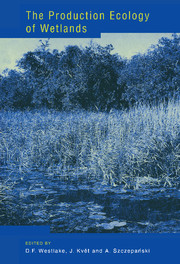Book contents
- Frontmatter
- Contents
- List of contributors
- Preface
- Foreword
- 1 General ecology of wetlands
- 2 Primary production in wetlands
- 3 Further fate of organic matter in wetlands
- 4 The role of decomposers in wetlands
- 5 The role of animals and animal communities in wetlands
- 6 Mineral economy and cycling of minerals in wetlands
- 7 Micro-climatic conditions and water economy of wetlands vegetation
- 8 The management of wetlands
- References
- Index
2 - Primary production in wetlands
Published online by Cambridge University Press: 27 October 2009
- Frontmatter
- Contents
- List of contributors
- Preface
- Foreword
- 1 General ecology of wetlands
- 2 Primary production in wetlands
- 3 Further fate of organic matter in wetlands
- 4 The role of decomposers in wetlands
- 5 The role of animals and animal communities in wetlands
- 6 Mineral economy and cycling of minerals in wetlands
- 7 Micro-climatic conditions and water economy of wetlands vegetation
- 8 The management of wetlands
- References
- Index
Summary
Introduction
The chapter is the result of co-operation between the authors. J. Květ and D.F. Westlake wrote much of the text, with the help of the contributors. The contributors researched or wrote the major part of: indirect methods, and structure and function of the assimilating organs, J.P. Ondok; quality of net production, genotypic variation and adaptations, Dagmar Dykyjová; comparisons of standing crop and productivity, E.J.P. Marshall.
Most wetlands are visually dominated by emergent vegetation, often large reeds or rushes, but the whole community of primary producers also includes substoreys of floating-leaved submerged macrophytes, periphyton, filamentous algae and phytoplankton, which may be quite important in some circumstances. The main emphasis will be on the behaviour of the dominants, but the other plants will be included where possible.
It will be assumed that the physiological features common to green plants are known and the chapter will concentrate on the special features of photosynthesis and growth by emergent plants. Submerged macrophytes, periphyton and phytoplankton are treated in more detail in the IBP-PF synthesis volume (Le Cren & Lowe-McConnell, 1980). Bradbury and Grace (1983) review primary production by Sphagnum, along with other wetland plants. Details on many of the topics discussed here, with particular reference to Phragmites australis, one of the most widespread dominant plants, will be found in Rodewald-Rudescu (1974).
- Type
- Chapter
- Information
- The Production Ecology of WetlandsThe IBP Synthesis, pp. 78 - 168Publisher: Cambridge University PressPrint publication year: 1999
- 4
- Cited by



